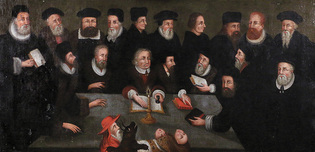 loading
loading
Arts & CultureA seventeenth-century surpriseObject lesson: A painting celebrating the Reformation had a secret beneath some paint. Art historian Felicity Harley-McGowan teaches in the religious studies department and the Divinity School.  Kathy HebbThe figures in the foreground of this picture, which were painted out well over a hundred years ago and only recently discovered, symbolize Catholic efforts to stop the Protestant Reformation. The painting is on display at the Divinity School through March. It will then be completely restored and all its original elements uncovered, including the names of Martin Luther (with book) and the Protestant leaders surrounding him. View full imageYale Divinity School, with so many others, is marking the jubilee of the Protestant Reformation this year. During the preparations, an unexpected find shone a light on one reason Protestantism spread: the Reformers were savvy exploiters of new media. This group portrait has been part of the school’s art collection for many decades, although how and when it came to YDS is unknown. Depicting a group of men around a table, it recalls the imagery of the Last Supper of Jesus; but in place of Jesus is Martin Luther, who instigated the Reformation in 1517, and in place of the disciples are other Reformers. Instead of blessing bread and wine, Luther extends his hands over a book. Directly in front of him is a lit candle, long a symbol of the Reformation. The portrait, from the late seventeenth or early eighteenth century, is one of many painted renderings of a print originally engraved and published in London around 1640. (The artist is unknown; the publisher, eminent in his day, was Thomas Jenner.) In the 1600s, new typeface technologies had initiated a media revolution, reducing the cost of publishing and circulating ideas with unprecedented speed. The ability to combine text and illustration enabled opinions to reach the hands of literate and illiterate alike. The print, which spliced text and image, capitalized on this development. In the original engraving, the Reformers are named, and emblazoned across the table are the words “The candle is lighted, we cannot blow out.” Four diminutive figures huddle together at the bottom of the print: a cardinal, a pope, a bull (a pun on “papal bull”), and a monk, who with faces upturned try to blow the candle out. This is not just a portrait but also a manifesto on the reform of the Church. By adapting the Last Supper iconography, it proclaims the Reformation’s shift of the center of piety—from the Sacrament to the Word. The humble printed original could have been kept inside the cover of a Bible, but amateur artists soon produced large painted versions for wealthier clients. From analyses of the printed versions produced in the seventeenth and eighteenth centuries, we know that the portrait lent itself to endless variation; some characters were excluded and others included in different times and countries. Yale’s painting is slightly later and less accomplished than many. And, from the time it arrived until very recently, Yale’s copy lacked the very components that gave the portrait its edge. The texts and the Catholic figures were absent. Then, this year, work on the painting by conservator Kathy Hebb revealed that the figures and text had been in the original work, but had been painted over in the eighteenth century. Yale’s painting was not a dreary anomaly. Quite the opposite: recent research has revealed that several versions known in Europe also survive in a mutilated state. In some cases, the canvas is folded to conceal the Catholic figures; in others it is simply cut away. The obliteration and resurrection of the figures add to the history of the image. Apparently, while the power of the portrait endured, its satirical portrayal of Catholicism lost currency. This year seems the perfect time not only to recall the Reformation, but also to consider the ways that the manipulation of media technology has a long and compelling history.
The comment period has expired.
|
|